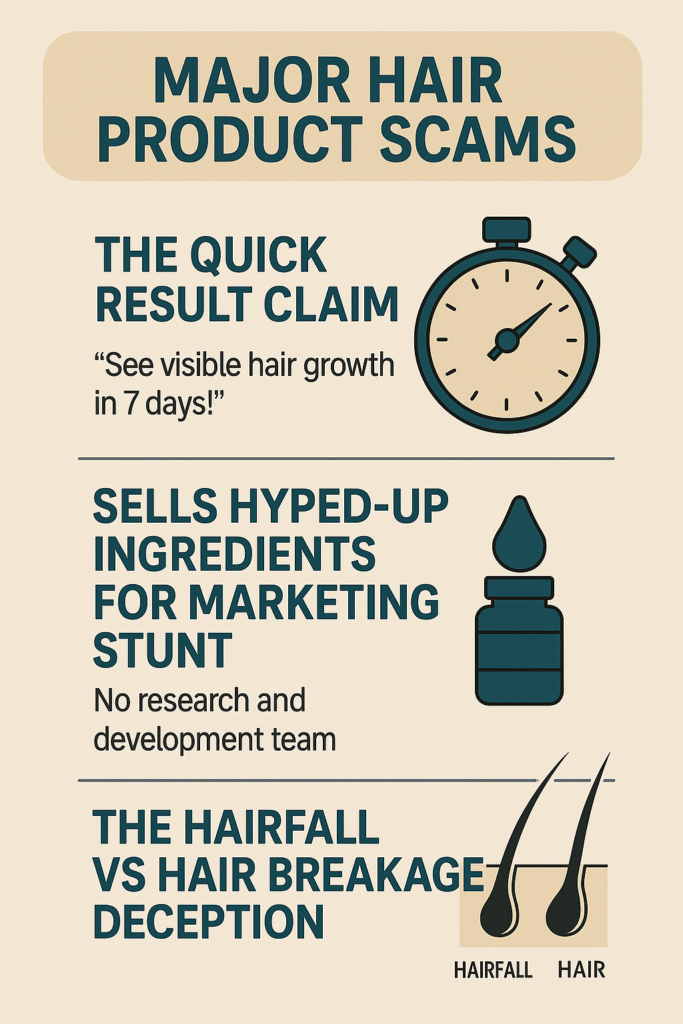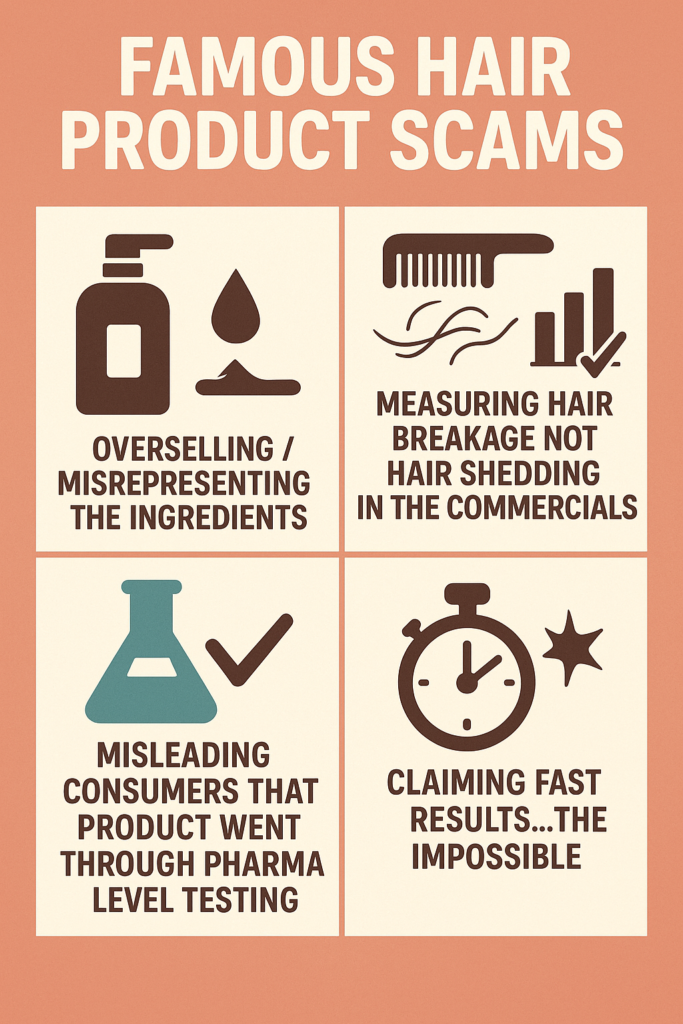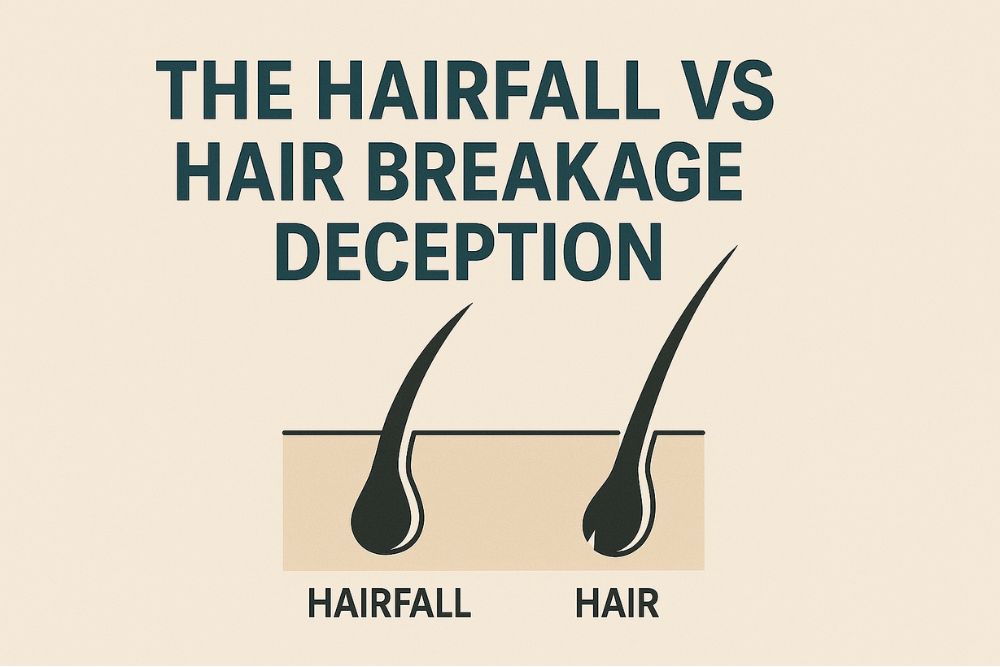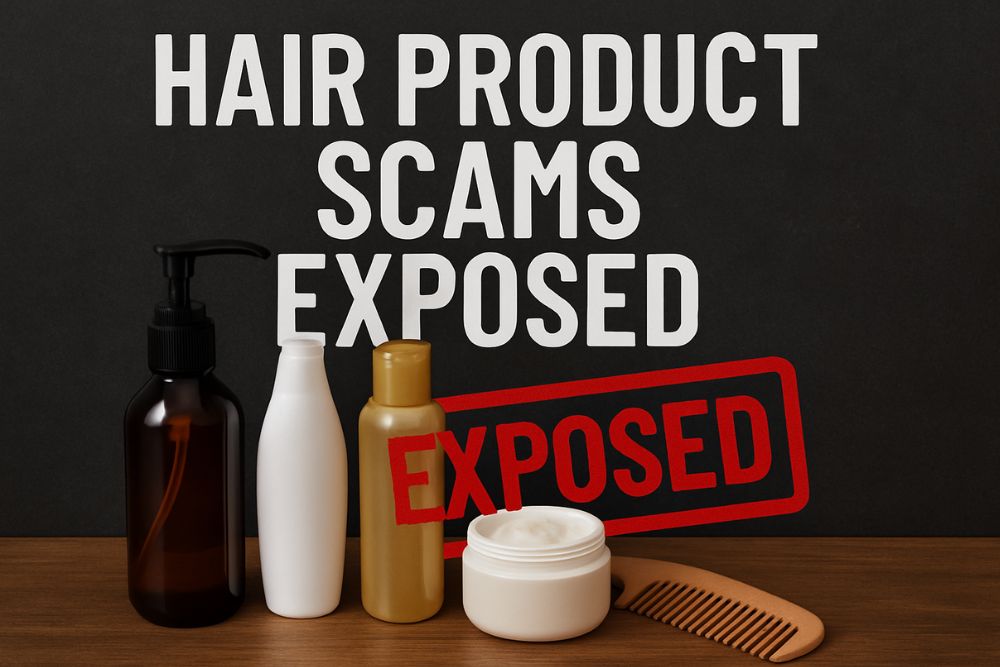Last updated on October 5th, 2025 at 06:06 pm
The 21st century has witnessed a surge in hair care innovations, but also scams. Not all hair products have delivered on their promises. From celebrity-endorsed products to viral social media trends, several hair products have been embroiled in controversies, leading to lawsuits, health concerns, and consumer distrust. Here’s an in-depth look at some of the most significant hair product scams of this century:
The “Quick Results” Scam: How Hair Care Brands Sell You False Timelines

We’ve all seen them:
👉 “Visible hair growth in 7 days.”
👉 “Reduces hair fall in just 3 washes.”
👉 “Stronger, thicker hair instantly.”
These promises flood shampoo bottles, hair serums, hair oils, and supplement ads. They sound irresistible—who doesn’t want rapid hair growth or instant repair?
But behind these catchy taglines lies a scientific reality brands don’t tell you:
✅ Meaningful hair improvement takes time—often 12 weeks or more.
✅ Biological processes like hair growth cannot be rushed by topical products.
✅ Most “quick results” are superficial, not structural or long-term.
Let’s break down how brands use false timelines to create unrealistic expectations—and why you need to be wary.
🕰️ The Reality of Hair Growth Cycles
Hair growth follows a biological cycle with three main phases:
- Anagen (growth phase): Lasts 2–7 years; hair grows ~1–1.5 cm per month.
- Catagen (transition phase): Lasts ~2–3 weeks; growth stops, follicle shrinks.
- Telogen (resting/shedding phase): Lasts ~3 months; old hair falls, new hair begins under the skin.
👉 Even if a product could stimulate follicles to stay in the growth phase longer, or improve scalp health, the visible results would take weeks to months to appear.
No product can create measurable hair density or length in a few days or weeks. Hair physically cannot grow fast enough.
🎯 Why Brands Promise Quick Results
So why do brands say “see results in 7 days” or “3 washes”? Because:
✅ They rely on subjective “feel” rather than objective improvement. → Hair may feel smoother or shinier after silicones coat the strands. This is surface-level masking, not repair.
✅ They define “results” vaguely. → “Stronger hair” may refer to reduced friction in lab combing tests, not actual structural reinforcement.
✅ They exploit placebo effect and optimism bias. → If you expect fast improvement, you’re more likely to perceive subtle positive changes.
✅ They want to trigger impulse purchases. → Promising fast results creates urgency and appeal to consumers frustrated with slow progress.
🧪 The Fine Print: How Claims Are Technically “True” But Misleading
Check the back of those “quick results” products and you’ll often find:
🔍 “Reduces hair fall due to breakage” → refers to fewer broken strands after combing—not stopping shedding from the root.
🔍 “Increases hair diameter temporarily” → refers to swelling from conditioning agents, which washes out next shampoo.
🔍 “Visibly improves hair health” → refers to shine and softness from silicones, not actual repair of damage.
👉 The words “visible,” “appearance,” “due to breakage,” and “temporarily” are legal loopholes brands use to make the claim sound stronger than it is.
🚩 What Brands Don’t Tell You: True Hair Improvement Takes 12 Weeks or More
Scientific studies on hair products, supplements, or treatments almost universally assess efficacy at 12 weeks or longer.
Why? Because:
✅ Hair grows ~1 cm/month. Any increase in density, strength, or quality needs new hair to emerge or damaged hair to grow out.
✅ Follicle-level improvement (from inflammation, poor circulation, nutrient deficiency) takes time to translate into visible strands.
✅ Even FDA-approved treatments like minoxidil only show measurable regrowth after 3–6 months of continuous use.
👉 A product claiming visible thickening, reduced hair fall, or growth in less than 8–12 weeks is overselling or misrepresenting the mechanism.
🕵️♀️ The “Before and After” Scam Tactic
Many ads show dramatic “before and after” photos labeled “2 weeks” or “1 month.”
But in reality:
✅ Lighting, angle, hair parting, or product residue (oils, fibers, sprays) are manipulated to exaggerate improvement.
✅ Models may have been using additional treatments or styling aids.
✅ Photos may reflect a styling effect (sleekness, shine) rather than growth or density.
👉 Brands know most consumers won’t wait 12 weeks to see if it really works. They exploit the desire for immediate validation.
📝 How to Spot (and Avoid) Quick Result Scams
Here’s how to protect yourself from misleading timelines:
✅ Look for clinical study duration. Legitimate studies run 8–12+ weeks minimum. Avoid products citing results after “7 days” without full study disclosure.
✅ Check if “results” are subjective or objective. Does “improvement” mean user-reported satisfaction, or is it measured by hair count, diameter, tensile strength?
✅ Be cautious of “instant repair” claims. Hair repair involves permanent structural bonds (e.g., disulfide bond repair in products like Olaplex), not just temporary cuticle coating.
✅ Don’t confuse cosmetic feel with biological change. Softness ≠ strength. Shine ≠ repair.
✅ Beware “visible growth” timelines under 12 weeks. True hair growth can’t be rushed.
💡 The Takeaway: Sustainable Hair Health Is a Long Game
👉 Hair health improvement is measured in months, not days.
👉 Effective treatments require consistent application, patience, and holistic care.
👉 Marketing promises “quick results” to bypass patience—but shortcuts rarely work.
Don’t fall for unrealistic timelines.
📅 Give credible products at least 3–4 months to show measurable change.
📖 Always read beyond bold claims—check the fine print, mechanism, and study duration.
✨ Your hair deserves patience, not pressure. Growth is gradual. True repair takes time. Don’t let false promises rush you into poor choices.
The Trendy Ingredient Trap: How the Hair Care Industry Sells Hype Over Substance
In the ever-evolving world of beauty and hair care, there’s always a new “miracle ingredient” making headlines. From argan oil to keratin, biotin, castor oil, rice water, and now rosemary oil, the list of trending ingredients seems endless. But behind the glossy commercials, influencer endorsements, and viral TikToks lies a sobering truth: many of these hair products contain only a tiny fraction of the star ingredient they’re selling you.
Let’s unpack how this marketing tactic works, why it’s misleading, and how you can protect yourself from falling for it.
🕵️♀️ The Marketing Formula: A Trend + Hype + Minuscule Amounts = Big Profits
Here’s the typical cycle:
- A natural ingredient starts trending—whether due to a viral video, a celebrity endorsement, or a small clinical study.
- Brands rush to slap that ingredient’s name on their packaging: “with argan oil!”, “infused with keratin!”, “biotin-powered!”
- Consumers, eager to try the latest beauty trend, flock to buy these products believing they’ll reap the ingredient’s full benefits.
- But what they don’t realize is that the ingredient is often added in such tiny amounts that it has little to no real effect.
In many cases, the ingredient is listed far down on the ingredients list, signaling a very low concentration—sometimes just enough to legally make the marketing claim, but not enough to provide therapeutic benefits.
🎯 Examples of Popular “Ingredient Scams” in Hair Care
Let’s look at some real-world examples where this tactic has been used:

✅ Argan Oil Shampoos: Around 2010, argan oil exploded in popularity. Many shampoos claimed to be “argan oil infused” but contained less than 1% of actual argan oil—sometimes diluted in silicones and other fillers.
✅ Keratin-Infused Products: “Keratin treatment” became a buzzword for smoothing frizz. But in over-the-counter products, keratin was included in hydrolyzed forms at very low percentages, without the transformative results of salon treatments.
✅ Biotin Shampoos: Biotin (vitamin B7) is widely advertised as promoting hair growth. However, topical biotin absorption is minimal, and most biotin shampoos include trace amounts that don’t significantly impact hair growth.
✅ Castor Oil Hair Products: Castor oil is praised for aiding hair thickness. Yet many serums list it among the last ingredients—meaning you’re mostly paying for fillers and preservatives.
✅ Rice Water Craze: Inspired by traditional beauty routines, brands began selling “rice water shampoos” containing synthetic fragrances mimicking rice water’s scent but negligible actual rice extract.
💡 Why Do Brands Do This?
👉 Legal Loopholes: Regulations allow companies to market a product as “infused with” or “contains” an ingredient even if it’s used in very small amounts—there’s no minimum quantity required to make that claim.
👉 Cost-Cutting: Pure, high-quality ingredients are expensive. Using trace amounts allows brands to lower production costs while charging premium prices.
👉 Psychological Effect: Consumers see the trendy ingredient name on the front label and assume the product is dominated by it—without ever flipping to the ingredients list.
🚨 Why This Matters: You May Not Be Getting What You Pay For
Using a hair product because it claims to contain a trending ingredient doesn’t guarantee results. If the ingredient is present in insignificant amounts, its supposed benefits—hydration, growth, strengthening—won’t materialize.
What’s worse: the majority of the formula may consist of harsh sulfates, silicones, synthetic fragrances, or alcohols that counteract the minimal benefits of the featured ingredient.
📝 How to Protect Yourself: Read the Label, Not Just the Hype
Here’s how you can outsmart these marketing tactics:
✅ Check the ingredient order: Ingredients are listed from highest to lowest concentration. If the star ingredient appears after preservatives or fragrances, it’s likely in very small amounts.
✅ Look for percentage disclosures: Some reputable brands list the percentage of active ingredients. No disclosure? Be cautious.
✅ Understand “infused with” claims: This wording does not specify quantity or potency—it’s often just a marketing buzzword.
✅ Research scientific backing: Is the ingredient proven to work topically? Some nutrients (like biotin) have better internal effects than topical benefits.
✅ Be wary of dramatic claims: “Magical hair growth overnight” or “10x stronger hair” are usually red flags.
🚩 Don’t Fall for It: Quality Over Trend
At the end of the day, hair care should be about consistent, well-formulated products tailored to your hair’s needs—not chasing every new viral ingredient.
Don’t let flashy marketing, influencer posts, or celebrity endorsements trick you into believing you’re getting a miracle cure in a bottle.
The real secret? A solid hair care routine, proven ingredients in effective concentrations, and realistic expectations.
So next time you see “with rosemary oil!” or “infused with rice water!” plastered across a shampoo bottle—flip it over and read the label before you believe the hype.
✨ Your hair deserves honesty, not marketing magic.
The Hairfall vs. Hair Breakage Deception: How Hair Product Commercials Mislead You

Have you ever watched a shampoo or hair oil commercial showing a woman combing her hair, staring horrified at the strands caught in the comb—and then cutting to a “miraculous” after-scene where the comb comes out clean? These ads claim to “reduce hair fall by 98%” or “stop hair fall in 2 weeks.”
Sounds impressive, right?
But here’s what the commercials don’t tell you:
👉 They’re not measuring true hair fall (from the scalp). They’re measuring hair breakage (mid-shaft breakage of the hair strand).
The “combing test” you see in these ads is not an accurate hair fall test—it’s a hair breakage test disguised as one.
Let’s unpack how this advertising trick works—and why you shouldn’t fall for it.
🧪 What Is the “Combing Test” Shown in Ads?
In these commercials, the product is applied to one side of the hair (or on different people). Then:
- A comb is passed through the hair.
- The number of broken hair strands caught in the comb is counted.
- The product claims a dramatic “reduction in hair fall” because fewer strands are visible in the comb.
They show you a “before” comb full of broken hairs and an “after” comb with barely any hairs—implying that the product stopped hair fall.
But here’s the catch:
✅ Hair fall (medically known as shedding) refers to hair naturally detaching from the root/bulb—which you can see at the end of a shed hair.
✅ Hair breakage is when the strand snaps somewhere along its length due to weakness, damage, dryness, or structural stress.
👉 A combing test can only measure breakage, NOT true hair shedding from the root.
🎯 Why Is This Misleading?
This marketing tactic conflates hair fall with breakage—two completely different biological processes.
- Hair fall (telogen phase shedding) is natural and happens due to genetics, hormones, nutrition, medical conditions.
- Hair breakage happens due to mechanical stress (brushing, styling), chemical damage (coloring, perming), or poor hair health.
A shampoo or conditioner might help reduce breakage by smoothing the cuticle or adding temporary coatings—but it cannot reduce hair shedding from the root unless it addresses an internal cause.
Yet the commercial’s dramatic “before and after” tricks the viewer into thinking the product stopped hair fall altogether—when it’s only reducing breakage.
🕵️♀️ The Visual Trickery of “Before and After” Ads
Advertisers use visual framing and psychological manipulation to exaggerate product claims.
Here’s how:
✅ Lighting and contrast: The “before” comb is filmed with bright light to show every hair; the “after” is filmed with dimmer light to minimize hair visibility.
✅ Comb technique: The “before” model may comb faster or more roughly; the “after” model combs gently.
✅ Pre-wash hair condition: The “before” hair might be dry, tangled, and unconditioned; the “after” hair is detangled, conditioned, heat-treated for smoothness.
✅ Time intervals: The “before” test may happen after multiple wash cycles of no product; the “after” test happens after a fresh product application.
👉 This creates the illusion that the product instantly solved hair fall—when in fact, it’s a carefully staged difference in hair condition and breakage susceptibility.
🚩 Why Does This Matter?
Many consumers (especially women worried about hair thinning) rush to buy these products hoping to “stop hair fall.” But when they don’t see improvement in hair density or scalp coverage, they feel misled or blame themselves for poor results.
In reality:
✅ Hair fall is often due to internal causes like hormonal imbalance, stress, poor nutrition, post-partum changes, or medical conditions like PCOS or thyroid issues.
✅ No shampoo or conditioner alone can stop root-level shedding unless it contains clinically proven actives (like minoxidil for androgenetic alopecia).
✅ Products that reduce breakage can improve the appearance of thickness temporarily—but they’re not a solution to hair fall from the scalp.
📝 What You Should Watch for in Ads
To avoid falling for this misleading marketing:
🔍 Check the fine print: Many ads quietly note in small text “due to hair breakage” after their “reduces hair fall” claim. They are legally required to clarify—but it’s often barely visible.
🔍 Look for studies vs. testimonials: Legitimate products will cite clinical studies. Ads relying solely on “consumer testimonials” or “lab tests” without peer review are weaker evidence.
🔍 Understand the limits of topical products: Conditioners, serums, shampoos can smooth the surface and reduce breakage. But treating hair fall from the root needs nutrition, scalp health, and sometimes medical intervention.
💡 Better Ways to Assess Hair Fall
Instead of a combing test from commercials, track hair fall by:
✅ Counting the number of shed hairs during your daily wash (normal is ~50–100 hairs a day).
✅ Checking for visible bulbs on shed hairs (a sign of root-level shedding).
✅ Consulting a dermatologist or trichologist if hair fall increases suddenly or exposes scalp patches.
📣 Conclusion: Don’t Let Ads Oversimplify Hair Science
Hair product commercials often exploit our fears of hair loss and use clever visual tricks to conflate breakage with shedding. The combing test they show is really a breakage test—not a true measure of hair fall.
Next time you see a shampoo claiming to “reduce hair fall by 98%,” ask yourself:
👉 Is this reducing breakage or actual shedding?
👉 Is there scientific backing—or just a combing demo?
👉 Am I addressing the right hair concern?
Remember: healthy hair starts from the scalp and the body—not just the bottle.
Don’t fall for marketing magic—read labels, question claims, and know the science behind your strands.
✨ Your hair deserves transparency—not manipulation.
The Research & Development Illusion: How Hair Care Brands Mislead You With Half-Truths
Walk into any beauty aisle or scroll through hair care ads online, and you’ll see it everywhere:
👉 “Scientifically developed.”
👉 “Backed by years of research.”
👉 “Formulated in state-of-the-art labs.”
👉 “Clinically proven ingredients.”
These claims sound impressive. After all, if a product was developed through research and development (R&D), surely it must be effective… right?
Unfortunately, not always.
The phrase “research and development” has become a marketing buzzword rather than a guarantee of scientific rigor. Many brands leverage it to build consumer trust, while overlooking critical aspects like ingredient concentration, formulation process, bioavailability, and product stability.
Let’s unpack what’s really happening—and what you should look for as an informed consumer.
🎯 What Does “Research and Development” Actually Mean?
In theory, research and development in hair care should involve:
✅ Identifying effective ingredients backed by scientific studies.
✅ Determining the right concentration of each ingredient to achieve results.
✅ Testing how ingredients work together in a formulation (stability, interaction, delivery).
✅ Verifying efficacy through clinical or consumer trials under controlled conditions.
However, in reality, many brands skip or shortcut these steps.
Instead, they:
❌ Choose popular or trendy ingredients with anecdotal hype.
❌ Add these ingredients at trace amounts—enough to list on a label, but too low to be effective.
❌ Skip rigorous testing and rely on supplier-provided data instead of independent research.
❌ Use generic base formulas and simply “drop in” the trendy ingredient without adjusting formulation science.
👉 Then they slap “developed through research” on the packaging—misleading consumers into thinking the product went through pharmaceutical-level testing.
🕵️♀️ Ingredient ≠ Formula: The Missing Link in Hair Care R&D
Here’s what most consumers (and even some marketers) misunderstand:
✅ A single ingredient having research doesn’t mean a product containing that ingredient is scientifically proven.
Example: Rosemary oil has studies showing potential benefits for hair growth. But:
- What concentration was used in the study?
- Was it pure oil, extract, or diluted?
- How often and for how long was it applied?
- What was the delivery system (carrier oil, alcohol, nanoemulsion)?
- Was it used in isolation or alongside other ingredients?
A shampoo advertising “infused with rosemary oil” might contain just a fragrance-level dose or a 0.01% extract—nowhere near the concentration or application method used in clinical trials.
👉 The product piggybacks off the research without replicating the study conditions.
🧪 The Overlooked Variables: Why Concentration and Process Matter
True research and development in hair care doesn’t stop at ingredient selection. It requires fine-tuning factors like:
🔬 Ingredient concentration: There’s a threshold dose for active ingredients to be effective. Anything below that is just a marketing label.
🔬 Delivery system: Ingredients need to reach the right layer (cuticle, cortex, scalp) in the right form. A molecule’s solubility, pH stability, and molecular weight affect absorption.
🔬 Formulation synergy: Some ingredients neutralize each other or become unstable in water-based formulas. Others need encapsulation or pH adjustment to work.
🔬 Application context: Does the product rinse off immediately? Is the active left on the scalp? Even the contact time changes efficacy.
When brands cut corners on these factors, they’re not doing full product-level research and development—just riding on ingredient-level research.
🚩 How Brands Exploit the R&D Claim
Here’s the typical marketing playbook:
✅ Find a popular ingredient trending online (e.g., biotin, keratin, rice water, caffeine).
✅ Source a basic cosmetic-grade version of the ingredient.
✅ Add it to an existing generic shampoo or conditioner base at trace quantity (below effective threshold).
✅ Reference scientific papers that studied pure or concentrated versions of the ingredient in different contexts.
✅ Declare: “Formulated with biotin, developed through research.”
✅ Run ads showing “scientific-looking” visuals (test tubes, lab coats, microscopes) to sell the image of scientific rigor.
👉 In truth, the product wasn’t tested or developed at the same standard as the research it cites.
⚠️ Why Does This Matter?
Because you, the consumer, are paying premium prices based on implied claims of efficacy.
Without proper concentration, formulation, and testing, a product may:
❌ Provide no meaningful results.
❌ Waste your time and money.
❌ Give a false sense of security (thinking you’re treating a hair issue effectively).
❌ Delay proper diagnosis or treatment if hair problems are medical.
The gap between ingredient claims and product reality can leave you chasing solutions that don’t exist in that bottle.
📝 How to See Through the “R&D” Marketing Hype
Here’s how to protect yourself from vague “developed through research” claims:
✅ Look for ingredient concentration disclosures: Serious brands list percentages of active ingredients (e.g., “2% minoxidil,” “5% niacinamide”). If there’s no number, it’s probably a trace.
✅ Check if the product cites product-specific studies, not just ingredient studies.
→ Ingredient-level research ≠ product efficacy. Has the product as a whole been tested?
✅ Watch for fine print qualifiers like “reduces hair fall due to breakage” or “improves hair strength when used with other products.” These narrow the claim’s scope.
✅ Beware of “clinically proven” without published data. If there’s no access to the study’s methodology, sample size, and results, it’s just a phrase.
✅ Don’t be swayed by “science visuals.” Test tubes in an ad don’t prove a product was tested like a pharmaceutical.
💡 The Takeaway: Demand Science at the Product Level, Not Just Ingredient Level
True research and development isn’t just throwing an ingredient into a formula. It’s about ensuring that ingredient:
✅ Is present at effective concentration.
✅ Is stable and bioavailable in the formula.
✅ Reaches the target site in the hair/scalp.
✅ Works synergistically with other ingredients.
✅ Has been tested in the final product form.
Without these steps, “developed through research” is just a decorative phrase.
As a consumer, you deserve transparency, evidence, and results—not borrowed credibility.
✨ Don’t just buy ingredients. Buy science that’s applied well. Your hair is worth more than marketing slogans.
FAQs About Hair Product Scams
How can you tell if a hair growth product’s claims are true or just exaggerated marketing?
Look for credible clinical trials (8-12+ weeks), check whether the product ingredients are listed in high enough concentration, read fine print (“appearance of”, “helps with”, etc.), and beware of promises of instant results.
Are “before and after” photos reliable evidence of a product’s effectiveness?
Not always. These images are often manipulated via lighting, styling, angle, or temporary effects (e.g. smoothness/shine) rather than showing real growth or repair.
What are “weasel words” in hair product marketing and why are they deceptive?
Weasel words are vague or ambiguous terms like “helps”, “appearance of”, “with natural extracts” that suggest strong benefits without clear evidence. They allow marketers to make enticing claims without outright lying
How common are fake reviews or misleading testimonials, and how do they affect consumers?
Very common. Many brands use selectively positive reviews, pay for influencer testimonials, or hide negative experiences. This misleads buyers about how effective or safe a product really is.




